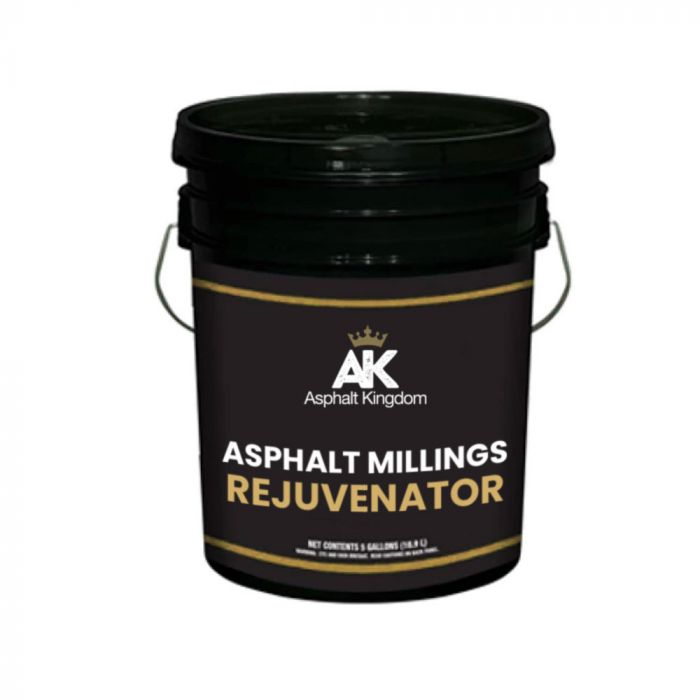Asphalt Millings Rejuvenator
- Rejuvenates old asphalt millings
- Creates a stronger bond
- Use for patching and potholes
Have questions? We’re here to help!

Asphalt Millings Rejuvenator – A Must-Have for Pothole Patching!
Asphalt Kingdom Asphalt Millings Rejuvenator – the ultimate solution for revitalizing all types of asphalt mixes. Whether you're dealing with hot mix, cold mix, recycled, or reclaimed asphalt and millings, this premium asphalt softener and rejuvenator will breathe new life into your pavement. It can be safely used in conjunction with infrared asphalt patching or hot boxes.
- A must-have for infrared asphalt patching
- Helps asphalt millings adhere to the existing asphalt during pothole repair
- A cost-effective way to rejuvenate old asphalt millings - no trip to the asphalt plant needed!
What is Asphalt Millings Rejuvenator?
Asphalt millings rejuvenator serves as a bonding agent for asphalt millings. If the asphalt is gray and oxidized, it has probably lost much of the tar, bitumen, and other elements that help it bind into a strong, durable material.
An asphalt rejuvenator, also known as asphalt millings binder, restores adhesion and helps make the asphalt look like new with a rich, dark color.
Asphalt Kingdom's 5-gallon pail asphalt millings rejuvenator is an asphalt-based emulsion that is user-safe and has a minimal odor. By the way, if you're doing a lot of work over the season, we offer larger sizes too - please call for more information. Our team is always happy to help.
Coverage is a breeze with our Asphalt Millings Rejuvenator, typically requiring 1 to 3 gallons per ton of asphalt. For precise calculations, consider using 0.5% to 3% of the total asphalt weight, which equates to approximately 7 lbs per gallon of the rejuvenator. For example, if you have 2000 lbs of asphalt, using 1% of that weight gives you 20 lbs. Divide 20 by 7, and you get approximately 2.8 gallons needed for the job.
How to Apply Asphalt Millings Binder for Infrared Patching
This pavement rejuvenator is ideal for infrared patching when the asphalt has lost its dark color. To use it, simply follow the instructions below.
- Warm the asphalt to the desired temperature using an infrared heater.
- Create loose millings by raking the asphalt surface.
- Apply a light coating of the Asphalt Millings Rejuvenator over the millings, allowing it to soak in for 5-10 minutes. Remember, there's no need to dilute the product – it's ready to use as is.
- Compact the asphalt effectively.
- Allow the asphalt to cool before opening it to traffic.
How to Bond Asphalt Millings Using a Rejuvenator with a Hot Box
Asphalt millings, also known as recycled or crushed asphalt, are a sustainable and environmentally friendly option for many property owners. It is also less expensive, making it an economical way to patch potholes.
If you have a large project that involves more than just pothole patching, you can use asphalt millings and asphalt millings rejuvenator to create your own hot asphalt. Use a hot box to heat the millings, and add the pavement rejuvenator (mixed with 50% water). Application rates will vary depending on the age of the asphalt and its porosity.
- Spray a thin coat of Asphalt Millings Rejuvenator onto the hot box walls before adding the mix.
- Fill the hot box up to about one-third capacity, and then evenly saturate the mix with the rejuvenator. Continue this process until the hot box is full. Typical coverage here is around 1-3 gallons per ton, depending on the asphalt's condition. Do not dilute the product – it's ready to use.
- Let the hot box sit for 12-24 hours, ensuring the rejuvenator fully saturates the asphalt mix.
- Apply the asphalt mix to the desired area and compact it efficiently.
- Allow the asphalt to cool before opening it to traffic.
We've helped a lot of people add Asphalt Patching to their existing businesses. Landscapers, snow plowers, pressure wash and window wash professionals have found this service easy and high margin - and best of all, it isn't weather sensitive! So if you're looking to increase your revenue outside of summer months, this is an excellent way to do it.
Important Precaution:
Avoid oversaturating the asphalt with Asphalt Millings Rejuvenator, as this could lead to excessive softening, hindering proper asphalt hardening.
Have questions? We’re here to help!

5
5 stars
100% (4)
4 stars
0% (0)
3 stars
0% (0)
2 stars
0% (0)
1 star
0% (0)
Share your thoughts with other customers
Top customer reviews
- Could not be happier with the service and supportCould not be happier with the service and support, I Have made several equipment purchases and material purchases through Asphalt Kingdom our service rep Adi is exceptional and so easy to work with. I would highly recommend asphalt kingdom for equipment and other related asphalt support.
- They gave me the service like I was their biggest customer.I just wanted to send in a review of one of your sales reps. Matthias Rosen was extremely helpful with any questions I had about the products and was very easy to work with there is a local business that sells similar products I can order in-store. He is the deciding factor of why I ordered with y’all he always answers calls whenever I call and also was patient when I talked to him 4 times probably over an hour for all 4 calls explaining your products to me so I could buy with confidence. I knowRead more I am a small contractor and for me, this was a big investment into my business but for your company, it probably was an insignificant amount of money overall and a small order. But Matthias Rosen gave me the service as if I was ordering a new paving machine. Even though it was a small amount for them they gave me the service like I was their biggest customer.
- Necessary for millingsThis is the cats meow, if you have gray millings, this makes them like new, stick like glue, easier to use. It's the easiest way to make the job easy and look like you are a pro.
- Happy with my purchaseI was able to use it and did not have any issues. I think it was great and did its purpose. I'm happy I purchase them!



